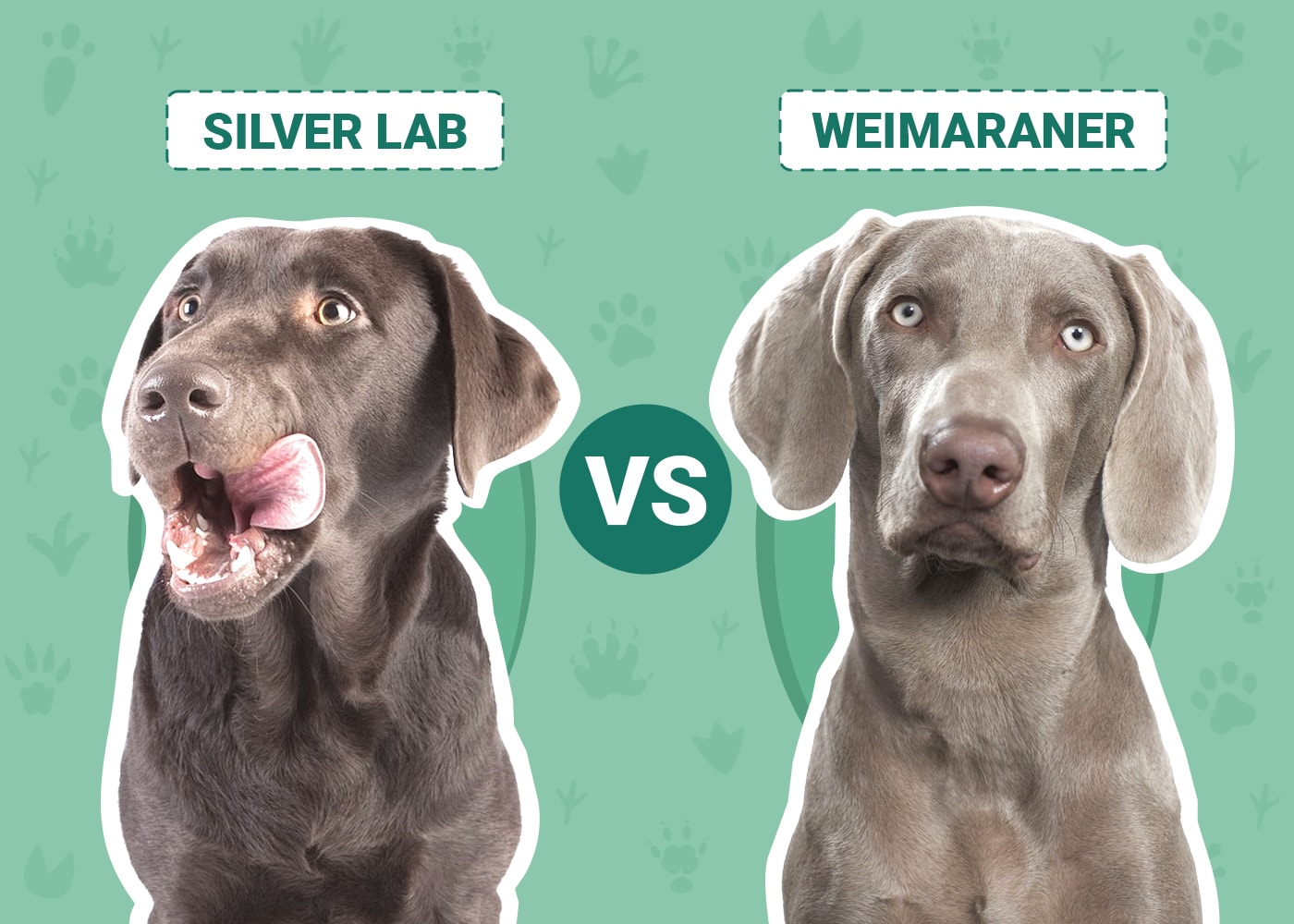Click to Skip Ahead
Silver Labs and Weimaraners are two dogs that draw a lot of comparisons. They are very similar in color and have a similar temperament. The similarities are so prevalent that some people ask whether Weimaraners and Silver Labs are related. But what exactly is the difference between a Silver Lab and a Weimaraner? Quite a lot, actually.
Silver Labs are purebred Labrador Retrievers and are a completely different breed from the Weimaraner. Weimaraners are hunting dogs that still retain a lot of their working pedigree, while Labradors have become extremely popular general-purpose dogs. The choice of which dog could be right for you will come down to a handful of key differences.
Here is everything you need to know about the difference between Silver Labs and Weimaraners.
Visual Differences

At a Glance
- Average height (adult): 23.5–25 inches
- Average weight (adult): 40–70 pounds
- Lifespan: 10–14 years
- Exercise: 1.5+ hours a day
- Grooming needs: Moderate
- Family-friendly: Yes
- Other pet-friendly: Yes
- Trainability: Extremely trainable, high energy, requires mental stimulation
- Average height (adult): 23–27 inches
- Average weight (adult): 55–90 pounds
- Lifespan: 10–13 years
- Exercise: 1–2 hours a day
- Grooming needs: Moderate
- Family-friendly: Yes
- Other pet-friendly: Often
- Trainability: Friendly, loyal, can be extremely obedient
Silver Lab Overview

Silver Labs are a type of purebred Labrador. Silver Labs are just a color of Labrador. That makes them nearly identical to Chocolate Labs, Yellow Labs, and Black Labs. Labradors are some of the most popular dogs in the United States for a reason. They are generally healthy, can be trainable, and often mature into amazing family dogs.
Silver Labs can be versatile dogs that can work for a very large portion of the population and nearly anyone who is interested in a traditional dog.
Personality
Silver Labs are fun, happy-go-lucky, and dopey. They are great with families and rarely ever meet a stranger. Silver Labs are good with children and other dogs. They can mature into amazing family dogs that are snuggly, cuddly, and friendly. Silver Labs often just want to have fun. They like to play, and they like to explore and go on adventures. They are rarely anxious and rarely aggressive.

Training
Labradors can be very trainable. However, when they are young and energetic, Silver Labs can be stubborn and difficult to manage. Silver Labs will need plenty of exercise, consistent training, and socialization in order to thrive. With a strong hand and consistent training,
Silver Labs can be obedient and loyal dogs, but they can be willful before the training takes hold. Some people might want to opt for training sessions if they get Silver Labs as puppies.
Health
Labradors are generally healthy dogs. Silver Labs, as purebred Labradors, have the same health profile as other Labs. Since Silver Labs have a recessive genetic profile, they can be more prone to health problems than other Labradors. The most common health issues are hip and elbow dysplasia, heart conditions, and blindness.
Labradors are also prone to frequent ear infections. Dysplasia conditions are also fairly common, especially in active Labradors.

Energy & Exercise
Silver Labs have very high energy levels when they are young, but they gradually slow down as they age. From puppyhood until around age five, Silver Labs will need a lot of physical activity and mental stimulation. After 5 years old, Silver Labs start to slow down and will gradually become lazier and cuddlier.
When Silver Labs are young, they will need long walks and frequent play sessions. As they age, they will need a more standard level of physical activity.
Suitable For:
Silver Labs can be suitable for almost anyone. They are great for general dog lovers, families, and active people. Potential owners should be aware that young Silver Labs are going to require a lot of time and attention. However, older Silver Labs can be very sweet and cuddly.
If you do not have the time and energy to deal with a Silver Lab puppy, you might want to consider finding a Silver Lab at the shelter that is older. Silver Labs appear in local shelters and at rescues more commonly than Weimaraners.
Weimaraner Overview

Weimaraners are athletic hunting dogs that have a lot of energy and a lot of personality. People love Weimaraners for their unique appearance, gorgeous color, and hunting pedigree. These dogs are perfect for people who like to spend a lot of time outside or who like to work out with their dogs. Weimaraners can also make loyal lifelong companions and good protectors.
Weimaraners can be very willful, especially when young, and you need to know what goes into their energy and personality before choosing a Weimaraner over another dog.
Personality
Weimaraners are known for being very loyal, obedient, and sweet. They do great with their owners and their families. However, Weimaraners can also be anxious and stressed. Anxious Weimaraners can often be on alert, they can bark a lot, and they might even nip.
These are usually not problems for a Weimaraner’s immediate owner or family but could affect strangers, friends, and extended family that are not around all the time.

Training
As working dogs, Weimaraners were bred to be trained. Weimaraners do very well on a schedule and have the ability to learn a large variety of commands. Weimaraners were meant to work alongside humans in order to complete a task or goal.
However, you do need to socialize your Weimaraner, and you need to manage their energy levels in order to increase your likelihood of getting the training to stick. Not everyone will be able to handle an overly energetic or stubborn Weimaraner.
Health
Weimaraners are very active dogs, and most of their health issues are exercise-related. Weimaraners are not prone to many congenital or genetic diseases or disorders. Weimaraners are prone to getting scrapes, cuts, and soft tissue injuries. They also are strong chewers, and they can chew objects and swallow things that they shouldn’t.
One of the most common life-threatening conditions is bloat (gastric torsion) which affects dogs like Weimaraners and Great Danes. Weimaraners are also prone to hip dysplasia and joint issues due to repeated physical motion.

Energy & Exercise
Weimaraners are extremely energetic, especially when they are young. Weimaraners were originally bred as working hunting dogs. That means that they are suited to spending a lot of time outside. They like to be moving, working, and exploring. Weimaraners need a lot of consistent exercise to keep their energy levels at a manageable level.
Weimaraners need both mental and physical stimulation. If you cannot take your Weimaraner for long walks, hikes, or out for long play sessions, you might want to consider making a different choice.
Suitable For:
Weimaraners can be suitable for a number of different people. Weimaraners are great for active people or families. They can also work for people who like to go hunting or hiking. Someone who is looking for a trainable dog with a high ceiling for learning will also get a lot out of Weimaraners.
These dogs are not suitable for someone looking for a couch potato dog or someone who needs to leave their dog alone for long periods of time with little stimulation.
Frequent Asked Questions (FAQ)
Are Silver Labs and Weimaraners Related?
No. Silver Labs and Weimaraners are not related. This is a common misconception due to the fact that Weimaraners and Silver Labs have a very similar color and a similar coat composition. Another reason that this is a misconception is that some unscrupulous breeders are breeding Weimaraner into Labradors in order to get the rare silver color.
Obviously, if you breed Weimaraner into a Labrador, the resulting puppies will no longer be purebred. True Silver Labs are purebred Labradors with a rare color with no relation to Weimaraners and no Weimaraner DNA mixed in.
Are Silver Labs Rare?
Purebred Silver Labradors are very rare. The silver color comes from a unique genetic pattern that is far less common than Chocolate, Yellow, or Black Labradors. In fact, Silver Labs are not accepted by the American Kennel Club (AKC) as silver is not an official breed color. Purebred Silver Labs can still be registered and recognized as a pure Labrador, but the color is not permitted to be shown in official competition.
Despite that, Silver Labs have been steadily growing in popularity, and more people are seeking them out because of their rarity. Silver Labs are the least common color of purebred Labrador.

Do Silver Labs All Have Blue Eyes?
No. Many Silver Labs are born with blue eyes and will have blue eyes as puppies. However, as they age, their eyes will often darken and change into a more common color. Many Silver Labs end up with eye colors typically found in other Labrador breeds, such as amber or green.
If you want to get a Silver Lab simply for their electric blue eyes, you might be disappointed if you end up with a Lab with basic brown eyes in the end.
Do Weimaraners All Have Blue Eyes?
All Weimaraners are born with blue eyes, but their eyes don’t always stay blue. A puppy’s eyes will start a vibrant blue or gray color before slowly changing into a color that will be more permanent. Weimaraner eyes can be blue, amber, brown, gray, or gray-blue.

Do Silver Labs or Weimaraners Cost More?
Silver Labs and Weimaraners both cost a similar amount. Weimaraners have a higher ceiling than Silver Labs due to the fact that a good working Weimaraner with a proven hunting pedigree can cost a considerable amount. The average cost of a Silver Lab is around $1,000, with the upper limit being close to $1,500. The average cost of a Weimaraner is also around $1,000, but the upper limit can be $1,700 to $2,000 for a quality purebred.
Silver Labs can cost considerably more than traditional Chocolate, Yellow, or Black Labradors due to their rarity and current popularity.
Which Breed Is Right for You?
Weimaraners and Silver Labs are similar on many levels. They have a very similar color, coat, and build. They can both be very trainable, very friendly, and highly athletic. Weimaraners require more stimulation and training than Silver Labs. They can also be more anxious, more stressed, and more aggressive than a Silver Lab.
Silver Labs are more typical dogs that are happy-go-lucky. If you want a large dopey dog, you will want to go with a Silver Lab. If you want a more athletic dog that thrives in a working role and likes structure, you will enjoy the Weimaraner.
- See Also: How Much Does a Shih Poo Cost?
Featured Image Credit: Top – Sandra M. Austin, Shutterstock | Bottom – Karolina Grabowska, Pexels









